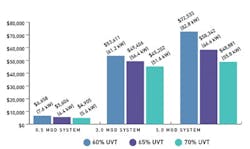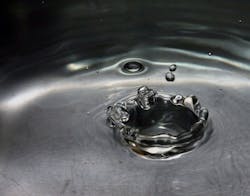About the author: Hari Venugopalan is director of product management for Crystal IS. Venugopalan can be reached at [email protected].
The water analysis instrumentation market is currently valued at approximately $2.5 billion, with 25% represented by online, real-time and distributed instruments. Global growth in this industry, heavily influenced by Europe and China, depends on the availability of lower cost instruments that meet increasing regulatory requirements. Manufacturers are turning to deep ultraviolet (UVC) LEDs as an enabling technology in these instrumentation applications.
Above image: Annual power consumption of three different levels of UVT in three different size systems.
Rapid detection of changes in water quality is critical in water delivery systems, wastewater treatment plants, and industrial plants for process optimization, environmental regulatory requirements and consumer health. Similarly, ship operators can optimize treatment of ballast water using water quality information and stay in compliance with the recently ratified International Maritime Organization Convention for the Control and Management of Ship Ballast Water and Sediments. Spectroscopy in UVC wavelengths is used to detect changes in water quality as they occur. By using continuous spectroscopic measurements instead of intermittent chemical testing with grab samples, end users can gather process information, detect issues in water quality and make the necessary process changes in real time.
Monitoring Water Quality
Water treatment facilities are increasing their use of UV light for drinking water disinfection, using mercury lamps that emit UVC light at 254 nm. Effective disinfection requires significant reduction in the concentration of bacteria, viruses and other microorganisms in water, and typically is denoted by a 2-, 4- or 6-log reduction in concentration. To achieve log reductions in the concentration of microorganisms, UV doses (a product of UV light intensity and time) above critical thresholds are required.
Understanding the UV transmittance (UVT) of water at 254 nm is key to ensuring that the UV light dose at the same wavelength is sufficient for disinfection. LED-based UVT monitors provide water treatment plants with real-time data to adjust their systems for the optimal UV dose.
A UV disinfection system is designed around an expected UVT, often based on historical information or periodic testing; however, this value fluctuates. Environmental changes, such as sudden weather events, seasonal changes in source water composition, or unplanned changes in upstream treatment processes, can affect UVT. In periods when the actual UVT is higher than the expected (or designed) UVT, the UV system will deliver more than enough UV intensity to disinfect the water. This translates into unnecessarily high-energy consumption. In periods when the actual UVT is lower than the expected UVT, the UV system will not be able to deliver enough UV intensity to meet disinfection requirements. Water quality will suffer, resulting in an immediate health risk. UVT monitoring can help eliminate the consequences of under- and overdosing.
By knowing the actual UVT, plant managers can reduce costs by preventing overdosing or eliminate environmental and public health hazards by preventing under-dosing. UVT monitoring also can detect organic events upstream of the UV disinfection process and may help reduce chemical consumption in coagulation, prevent membrane fouling and extend the life of the carbon used in filtration.
Traditional UVT monitors used mercury lamp light sources. Mercury lamps require a longer warm-up time to achieve stable measurement results, so they typically are left on continuously, resulting in frequent lamp replacements. Due to the variability in lamp output, several measurement techniques involving different path lengths, multiple lamps and sensors or other methods of compensation have been used. These features often require more moving parts, resulting in a much larger product with a higher level of maintenance required to continue reliable operation. In contrast, UVC LEDs are instantly at full power to take a measurement on-demand and can be turned off to preserve the overall life of the UVC LED. Consequently, LEDs can be operated five to 10 times longer than mercury lamps before they need to be replaced, which allows for a lower cost of ownership. They also are more robust and have the advantage of being manufactured without mercury.
Reliable Water Testing
Replacing a traditional mercury lamp with a UVC LED also enables a smaller footprint for UVT monitors, making it easy to use across multiple water treatment environments: directly in a pipe, in an open channel or offline as a battery-operated handheld instrument.
As mentioned previously, water treatment plants can reduce operating costs across the plant by monitoring UVT in real time to optimize the UV dosage. To quantify the reduction in operating costs, the impact of real-time monitoring on energy consumption was investigated for disinfection plants of different capacities.
Viewing SCADA with tablet
An expected dose of 30 mJ per square centimeter was used for all scenarios. The data show that in order to achieve an effective UV dose, more power (UV intensity) was required for the lower levels of transmittance than for the higher levels of transmittance. This is because when UVT is lower, more energy is required for the UV light to penetrate the water and provide adequate disinfection. This extraneous energy usage can be quantified in energy costs.
For example, a 0.5-million-gal-per-day (mgd) UV system operating at 60% UVT would cost approximately $1,700 more annually to operate than the same UV system operating at 70% UVT. By comparison, the same UVT ranges would yield an energy consumption difference of approximately $8,400 per year for a 3-mgd system and more than $23,000 annually for a 5-mgd system. This study confirmed that small changes in water quality throughout the year (from 5% to 10% UVT) have the potential to directly affect a facility’s operating costs. The potential year one savings that could be realized by implementing a UVT monitoring solution are often greater than the one-time cost of purchasing a UVT monitor.
The recent emergence of high-performance UVC LEDs is leading to increased adoption of this solid-state light source in water and wastewater monitoring applications. UVC LEDs are driving innovations in instrument design for water quality monitoring that address key market trends around productivity, cost reduction and miniaturization. As high-performance UVC LEDs are available at shorter wavelengths, the possibility of low-cost smart water sensor networks for monitoring additional parameters or compounds, such as nitrates and other key environmental pollutants, becomes a reality.


